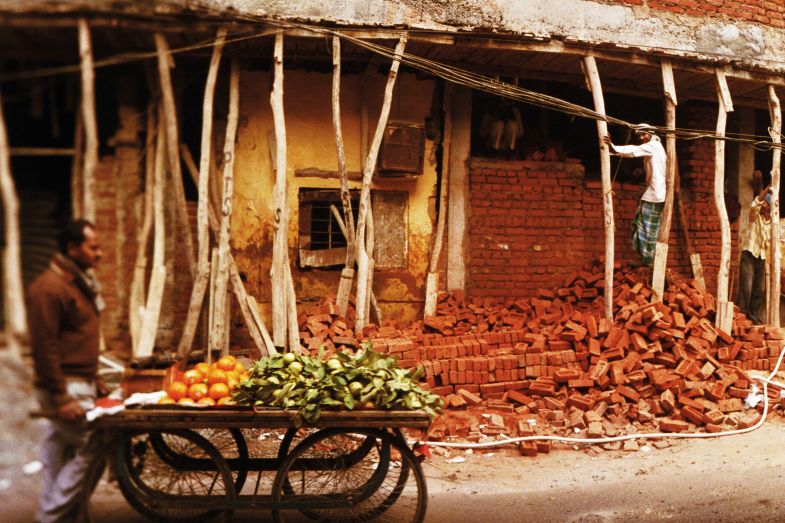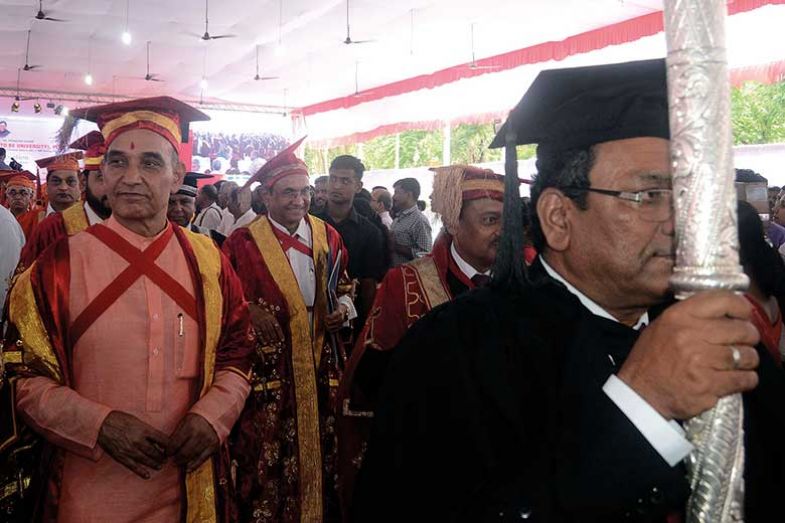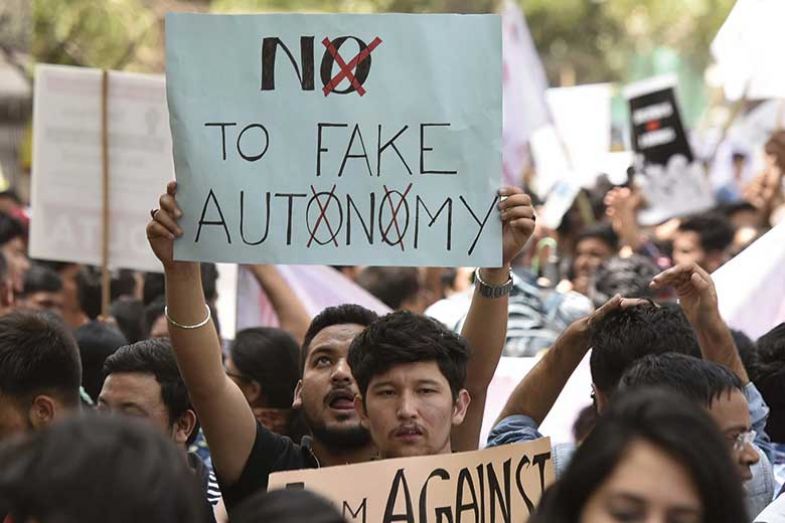Indian education consists of “islands of excellence floating in a sea of mediocrity”. This candid verdict, voiced in 2014 by the country’s then minister of state for human resource development Shashi Tharoor, is particularly true in the sphere of higher education.
Since independence, the challenges of building a mass higher education system in a context of inadequate government funding has meant poor quality, increasing privatisation, and politicisation.
In 2013, the Indian government launched a major reform initiative. Known as RUSA, it aims to provide additional strategic funding to state higher education institutions in a bid to drive up quality and capacity in the system. B. Venkatesh Kumar and Ashok Thakur from the Indian Institute of Technology Bombay note that this funding increased India’s access rate to higher education from 19.4 per cent of the eligible population to 25.2 per cent between 2013 and 2017, and reduced faculty vacancies from 60 per cent to 19.4 per cent in government-funded post-secondary institutions. However, student completion rates remain problematic and staff vacancies are still significantly higher at “unaided” institutions that receive no direct public funding.
Moreover, while more recent research shows that the access rate further increased to 25.8 per cent in 2018, the number of teachers in higher education has been declining during the past few years, and the pupil-to-teacher ratio in universities and colleges remains only 1 to 30.
Public investment also continues to be distributed extremely unequally. Recent data shared in the Indian national parliament by Satyapal Singh, minister of human resource development responsible for higher education, reveal that during the past three years, more than 50 per cent of the federal government’s funding for higher education has only benefited the 3 per cent of the country’s students enrolled at centrally funded institutions such as the Indian Institutes of Technology (IITs), Indian Institutes of Management (IIMs) and National Institutes of Technology (NITs). These institutions are among the islands of excellence that Tharoor was alluding to. Other examples include the centrally funded Indian Institute of Science, Tata Institute for Fundamental Research and Jawaharlal Nehru University, as well as private institutions such as the Manipal Academy of Higher Education, and the Birla Institute of Technology and Science, Pilani (BITS Pilani) – all highly regarded research and teaching institutions. There are a few others, too. But in a system that now enrols 35 million students – more than any other country except China – these are indeed mere drops in the ocean of mediocrity.
Occasional rhetoric from officials continues to make a mockery of Indian higher education and science. A recent example is comments that Singh made earlier this year questioning the validity of Darwin’s theory of evolution. With such little faith in science, India’s intention to launch a manned space mission by 2022, announced by prime minister Narendra Modi a few months later, during his Independence Day address on 15 August, seems unlikely to come to fruition.
Another worrying recent development is the government’s intention to replace the University Grants Commission (UGC) – the central agency responsible for both providing funds and overseeing quality standards – with a new body, the Higher Education Commission of India (HECI), which would be focused exclusively on improving academic standards and quality. The UGC’s grant-awarding role would pass to the Ministry of Human Resource Development, potentially allowing politicians to use their financial clout to override institutional autonomy. But southern states such as Kerala and Tamil Nadu have already opposed the move (both the federal and state governments have the power to enact higher education legislation, but if there is a conflict, the federal government’s legislation prevails). And, at present, the prospects of the legislation being passed by the national parliament look slim.
Even if this piece of legislation is flawed, it illustrates that at least the central government appears finally to have recognised the key role for higher education in India’s development and global engagement. And, after a half-century of academic lethargy, other initiatives it has recently introduced are pleasantly surprising and potentially game-changing.

The National Institutional Ranking Framework (NIRF), first implemented in 2016, is India’s first government-supported ranking of colleges and universities. Perhaps stimulated by India’s dismal performance in global league tables, the ranking may guide government financial support for higher education in the future. It also provides the basis for differentiating among colleges and universities. It has been criticised for an overly complicated methodology (in India, such complexity often gets in the way of practical solutions). And participation has, to date, been modest: it is clear that the ranking needs to be extended throughout the higher education system. But it is at least a start, forcing participating institutions to submit data on critical areas and thereby permitting government to make key decisions based on evidence. Unsurprisingly, though, there are allegations that some private institutions manipulate the process.
Meanwhile, the Global Initiative of Academic Networks, launched in 2015, has been assisting Indian institutions to attract distinguished international academicians and experts to deliver specialised courses by easing regulations and providing some additional funding. Only the handful of institutions with an “A category” ranking from the National Assessment and Accreditation Council, India’s quality assurance agency, are permitted to participate, but, despite that, the programme has already brought more than 700 foreign faculty to India. The chances of their remaining beyond the short term of the programme, however, are strictly limited by the existing regulatory framework, low Indian salaries, infrastructure problems and the inevitable challenges of bureaucracy. In this context, it will be interesting to see the impact of the recent push by the IITs to hire permanent foreign faculty.
Some initiatives by the government’s Department of Science and Technology are also having an impact. Notable among these is the Visiting Advanced Joint Research Faculty Scheme, launched last year, which aims to stem the Indian brain drain by enabling non-resident Indians (as well as other overseas scientists and academicians) to contribute to research and development in a priority area for between one and three months at a publicly funded research institution. Participants receive a lump sum of $15,000 during the first month, and $10,000 a month thereafter. The host institution is required to provide additional support.
Another promising scheme is the creation by the government’s National Institution for Transforming India of what are known as Atal Incubation Centres: world-class facilities aimed at fostering innovation and entrepreneurship in manufacturing, transport, energy, education, agriculture, water and sanitation at selected higher education institutions. However, the programme needs considerably more financial and other kinds of support than is currently provided.
But perhaps of greatest importance are two recent innovations aimed at creating world-class universities. The first of these is the Institutions of Eminence (IoE) project, which emulates the other “excellence initiatives” now common worldwide that provide extra funding to encourage innovation. The initial idea was that 20 universities – 10 public and 10 private – would receive this designation, with the publics being provided with significant additional government funding and the privates given enhanced autonomy. Singh stated in parliament that each selected public institution will receive about $146 million over five years.
However, after considerable suspense and speculation, only six institutions – three public and three private – were selected in July. The public institutions are the Institute of Science, Bangalore; IIT Bombay and IIT Delhi. The private sector institutions are BITS Pilani, the Manipal Academy of Higher Education and the Reliance Foundation’s as yet unbuilt Jio Institute. The last was given its own “greenfield” category, but since so little is known of the foundation’s plans, its inclusion was a surprise.
Even upgrading six Indian universities to world-class quality will take time and consistent funding, probably at a scale beyond what is envisaged in current plans. Furthermore, greatly increased autonomy will be needed – and freedom from the bureaucratic shackles of government would be a departure from Indian tradition. In this regard, the related Graded Autonomy Programme will be immensely important. This provides participating colleges and universities with considerable academic, financial and administrative freedom. If appropriately implemented, it will be a significant stimulus for innovation in areas such as academic programmes, international partnerships and campus diversity, and just over 50 universities, both private and public, as well as eight colleges have so far been given “graded autonomy” status, provoking protests from some (see picture below right).
But mechanisms to release the imagination of Indian academics will also be necessary. Perhaps because of the crushing influence of bureaucracy, India’s capacity for academic innovation has always been very limited and has never been implemented in the comprehensive universities that are the heart of any academic system. Visionary leadership will be key, and carefully studying what has worked abroad may provide useful ideas.
Speed is also of the essence. As the 2019 parliamentary elections are drawing closer, key decisions concerning the implementation of the IoE programme need to be made quickly. Otherwise it will share the fate of the “Research and Innovation Universities” programme proposed by the previous government in 2012: a non-starter from the beginning owing to political and academic challenges.
Another area in which India needs to improve significantly is internationalisation. The country’s inability in recent years to pass legislation permitting foreign branch campuses and relationships with overseas universities is a reflection of the problem.

But there are promising signs. The Graded Autonomy programme makes it easier to hire international faculty. And the government’s new “Study in India” initiative aims to double India’s tiny share of the world’s international students from 1 to 2 per cent. Although nearly 600,000 Indians are studying abroad, India’s previous lack of interest in attracting international students to its shores means that only about 70,000 study there, compared with almost 400,000 in China. Around a quarter of those are from neighbouring Nepal, with nearly 10 per cent from Afghanistan and 5 per cent from Sudan.
What is important about the Study in India programme is the recognition that India needs to play a greater role in international higher education. To that end, the country is moving towards signing agreements on the mutual recognition of academic qualifications with 30 other countries, having already signed one with France.
The recently announced Scheme for Promotion of Academic and Research Collaboration (SPARC) also looks promising. This initiative, to be coordinated by IIT Kharagpur, aims at promoting joint research with top international universities in certain priority areas still to be comprehensively identified by the government.
But, encouraging though all this is, the reality is that all of these initiatives are limited to a small, elite segment of India’s vast and poorly coordinated higher education system, a significant and ever-growing proportion of which is made up of private institutions.
According to latest official statistics, there are 903 universities in India. Of these, 343 are privately managed. Moreover, nearly four out of five colleges are in the private sector, catering to just over two-thirds of total enrolment. The majority of the programmes in private colleges and universities focus on professional areas such as management, engineering and a few other disciplines that are in high demand in the domestic and international labour market. Indeed, the vocationalisation of degrees in the private sector has evolved to the extent that institutions specifically billing themselves as “skills universities” have begun to spring up. Examples include TeamLease Skills University and the Symbiosis Skills and Open University.
But while the private sector has been central to improving access to higher education, the quality of much of it is poor, and students are not adequately protected by regulatory bodies. In that context, it has been extremely encouraging to witness the recent emergence of elite, non-profit private universities, such as Azim Premji, Ashoka, Shiv Nadar, O. P. Jindal and – the latest – Krea University. Reflecting a different trend altogether, these are backed by prominent entrepreneurs and big business and focus on liberal arts and interdisciplinary study, in contrast to the specialised approach followed by the majority of Indian institutions. They are also effective at establishing and nurturing international partnerships, and some facilitate international internships and offer dual degrees or twinning arrangements.
But all of this comes at a high price. And it is nowhere near enough when it comes to internationalisation. More thinking at the national level is required. For example, it is not enough to focus on full degree programmes and to target only students from Asia and Africa. Western students will not be attracted to India for degree study, but could be lured for short-term programmes or other innovative arrangements. India has the tremendous advantage of using English as the main language of higher education, and the presence of Western postgraduates and postdoctoral researchers is necessary to facilitate the development of new ideas.
So while the sleeping giant of global higher education is starting to stir, it is clear that further, carefully implemented measures will be necessary before the country’s progress can truly be called an eye-opener.
Philip G. Altbach is research professor and founding director of the Center for International Higher Education at Boston College. Eldho Mathews is senior researcher in higher education at the New Delhi office of international consulting firm Sannam S4.

Reforming India’s HE system: Western universities could help more
In the mid-2000s I swapped Edinburgh for a year teaching in a state-run college in the Indian city of Meerut, in Uttar Pradesh. Near the city centre campus’ gate was the decrepit physics block. A student had scrawled in huge white letters: “In need of an acadmic atmosphere” (sic).
This piece of graffiti was like a giant projection of the mood of the students. One told me: “The equipment here is like the equipment in your country 50 years ago. They should throw it down a well.”
There were a few students who called themselves the Chingari group; Chingari means “spark” in Hindi. They worked to try to critique mismanagement in universities and campaigned for better facilities. But the general mood was depressing. Many students told me that their student years amounted to little more than “timepass”: an Indian phrase denoting the aimless and unproductive use of time.
One of the most striking global challenges of the 2020s is the reform of Indian higher education. One in 10 people in the world is an Indian youth, and while participation rates among 18-23-year-olds have risen from only 6 per cent in 1990 to nearly 25 per cent, it is still true that only a tiny fraction of Indian youth are likely to be able to study in a university in the conventional sense of the term.
More than 90 per cent of Indian students study in institutions run by India’s states. These are very poorly regulated, have woeful facilities and are critically underfunded. Only 5 per cent of India’s research and development budget goes to higher education, and only a tiny portion of that goes to state-run institutions.
An employability assessment firm recently claimed that only 5 per cent of students emerging from India’s engineering colleges have skills relevant to the employment market, and McKinsey arrived at similarly dismal figures a decade ago. Interdisciplinarity is rare because universities lack the organisational infrastructure to foster it and because of a deep-set lack of respect for social sciences and the humanities.
India has some world-class higher education institutions and a long and deep tradition of critical, problem-based education. A few excellent private universities have emerged recently, such as Shiv Nadar and Ashoka universities. And there are some exciting developments occurring in Indian Institutes of Technology. But these are the exceptions.

Given the mind-bogglingly large scale of reform and investment required, it is at this point that many readers will switch off, concluding that meaningful change is unrealistic. Academics and university leaders in the West will ask why any of this should concern them anyway.
The answer is that universities across the world are increasingly connected to India via their inflow of elite Indian students. This arguably imposes on them a moral obligation to address India’s higher education crisis. But there are also more self-interested reasons for doing more. Engaging with regional Indian higher education would further increase global research universities’ access to the wealth of talent that is currently so underserved in India – and which, increasingly, has the funds to invest in something better.
Nor is the challenge of reforming India’s university system entirely insurmountable. One important part of the answer is to develop partnerships with elite institutions in India as a bridge to connecting with state-run universities in the same region. Shiv Nadar and Ashoka are already sparking improvements in their immediate regions by, for example, conducting outreach in schools, offering scholarships and bringing local college principals on to campus for training and discussion. It is easier to partner with these elite private institutions because they are less encumbered by bureaucracy than are the government universities.
Overseas universities have much to learn from what top Indian private universities are doing. But, in a spirit of two-way partnership, foreign universities also have a lot to offer. First, they could encourage the India experts among their faculty to build personal connections with these top privates in order to facilitate academic exchange. Second, they could partner with Indian institutions to develop scholarships for students from disadvantaged Indian backgrounds. And, third, they could reflect on how their efforts to engage with their own local regions might inform Indian private universities’ outreach initiatives.
Progress may be slow. Many senior figures in universities in provincial India, including vice-chancellors, have a stake in the status quo. But this should not discourage those global educational institutions who spy opportunities from partnering with India’s “sparks” to ignite the most important higher education revolution of modern times.
Craig Jeffrey is director and CEO of the Australia India Institute at the University of Melbourne. He has spent 23 years undertaking anthropological fieldwork in western Uttar Pradesh and Uttarakhand.
后记
Print headline: Against all odds
请先注册再继续
为何要注册?
- 注册是免费的,而且十分便捷
- 注册成功后,您每月可免费阅读3篇文章
- 订阅我们的邮件
已经注册或者是已订阅?




